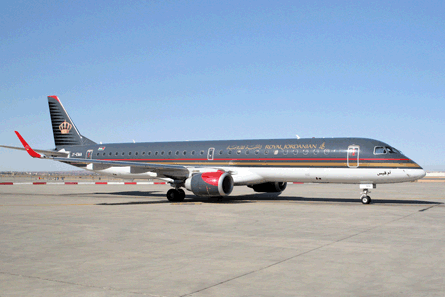Embraer aims to capitalise on its early successes in penetrating the Middle Eastern market with its E-Jet family of airliners, by placing the type with several more airlines and doubling its fleet in the region within the next five years.
The ambitious Brazilian manufacturer meanwhile plans to select during the first half of 2010 a location for a Middle East spares warehouse, aimed at enabling the manufacturer to better support its growing band of airline customers in the region.
There are four airline-controlled Embraer spares centres in the Middle East, in Cairo (EgyptAir), Amman (Royal Jordanian), and Riyadh and Jeddah (Saudi Arabian Airlines and NAS), which are supplied via Embraer's European warehouse in Paris, France.
 |
|---|
© Royal Jordanian |
Setting up the Middle East facility is "something that we want to do quickly, but it's a very complex analysis that we have to do", says Jose Luis Molina, Embraer airline market vice-president for Europe, Africa and the Middle East.
"Initially, we have the intention to establish a partnership with a local company," he adds. "Oman is an option, as are Dubai, Abu Dhabi and Bahrain."
Embraer's four Middle Eastern airline customers have ordered around 50 E-Jet family airliners to date and the manufacturer is in talks with several more prospective buyers in the region.
"We believe that in four to five years we can double the fleet in the region," he says. "We believe that the E-Jets offer very good economics for the airlines here. We believe that we still have very good opportunities to grow here in the Middle East.
"We are working with many airlines in the region, and we are talking about six opportunities. Oman Air is one customer we have been working on for some time."
Embraer senior manager marketing Byron Bohlman says EgyptAir provides a "perfect example" of the E-Jets philosophy. Before the carrier's Express subsidiary introduced its fleet of E-170s in 2007, the Egyptian flag carrier had offered four daily flights between Sharm el Sheikh and Cairo, using a mix of Airbus A320-family aircraft, A330 widebodies and Boeing 737s.
The route is now served 11 times daily, with nine of the rotations employing the E-170.
"EgyptAir has preserved its overall capacity, but has a much more market friendly schedule," says Bohlman.
Although the extra frequencies entail higher crew costs and additional landing charges, "they would not have done this were it not feasible to do so economically", he adds. EgyptAir Express operates 12 E-170s on 28 routes.
Royal Jordanian operates five E-195s and a pair of E-175s on 47 city pairs, and plans to add two more examples of the latter to its fleet, says Royal Jordanian chief executive Hussein Dabbas.
"We haven't decided yet, but [two additional E-175s] are on our radar screen for the next couple of years," says Dabbas.
He describes the E-Jets as "economical to operate, but attractive to customers".
The Amman-based carrier introduced Bombardier Dash 8 Q400 70-seat turboprops in 2006, but "customers didn't feel comfortable flying on them", says Dabbas. "I think it's basically a lack of understanding and knowledge," he adds.
Dabbas says the airline also looked at Bombardier's CRJ regional jets, but rejected them as they were unable to use the airbridges at Royal Jordanian's home base of Queen Alia International airport in Amman.
NAS of Saudi Arabia operates its six-strong E-190/195 fleet on 25 routes, and has four more aircraft on order, while Saudi Arabian Airlines operates its E-170s on 62 routes.
Source: Flight Daily News
















